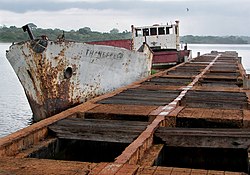Quinara Region
| Quinara | |
|---|---|
| Region | |
 |
|
 Quinara Region |
|
| Country | Guinea-Bissau |
| Seat | Buba |
| Sectors | Buba, Empada, Fulacunda, Tite |
| Area | |
| • Total | 3,138.4 km2 (1,211.7 sq mi) |
| Population (2009 census) | |
| • Total | 63,610 |
| • Density | 20/km2 (52/sq mi) |
| ISO 3166 code | GW-QU |
Coordinates: 11°40′N 15°10′W / 11.667°N 15.167°W
Quinara is a region in central Guinea-Bissau and its capital is Fulacunda. There has not been any local administration since the civil war of 1998-99 and all the social services are done by organs of civil society and other government agencies. It is a coastal region covered with Mangrove swamps, rain forest and tangled forest and receives an annual rainfall of more than 1,000 mm (39 in).
As of 2009, the total population of the region was 60,777, with the urban population being 12,302 and rural being 48,475. The sex ratio of the region is 94 females for every hundred males. As of 2009, the net activity rate was 45.54 per cent, proportion of employed labour force was 33.16 per cent, proportion of labour force was 76.09 and the proportion of potentially active population was 33.16 per cent. The absolute poverty rate, people earning less than $2 a day, in the region stood at 79.6 per cent, with a regional contribution of 18 per cent to the national poverty totals.
Quinara is a low-lying coastal region and the low-lying coastal areas are periodically submerged during high tide. All the coastal regions have a maximum elevation of 300 m (980 ft). The internal region has plains, which are interspersed with rias. There are lot of meandering rivers, many of them forming estuaries in the coastal regions. The principal river, Cacheu, flows through the region. The climate is hot and tropical and the region has two seasons. The onset of summer is from December to May with April - May period having temparature ranges from 20 °C (20 °C) to 30 °C (30 °C). The rainy season is usually from May to November. The region receives an average rainfall of around 2,000 mm (79 in) compared to the inland regions, which receive 1,000 mm (39 in). The coastal regions are covered with Mangrove swamps, rain forest and tangled forest.
...
Wikipedia
